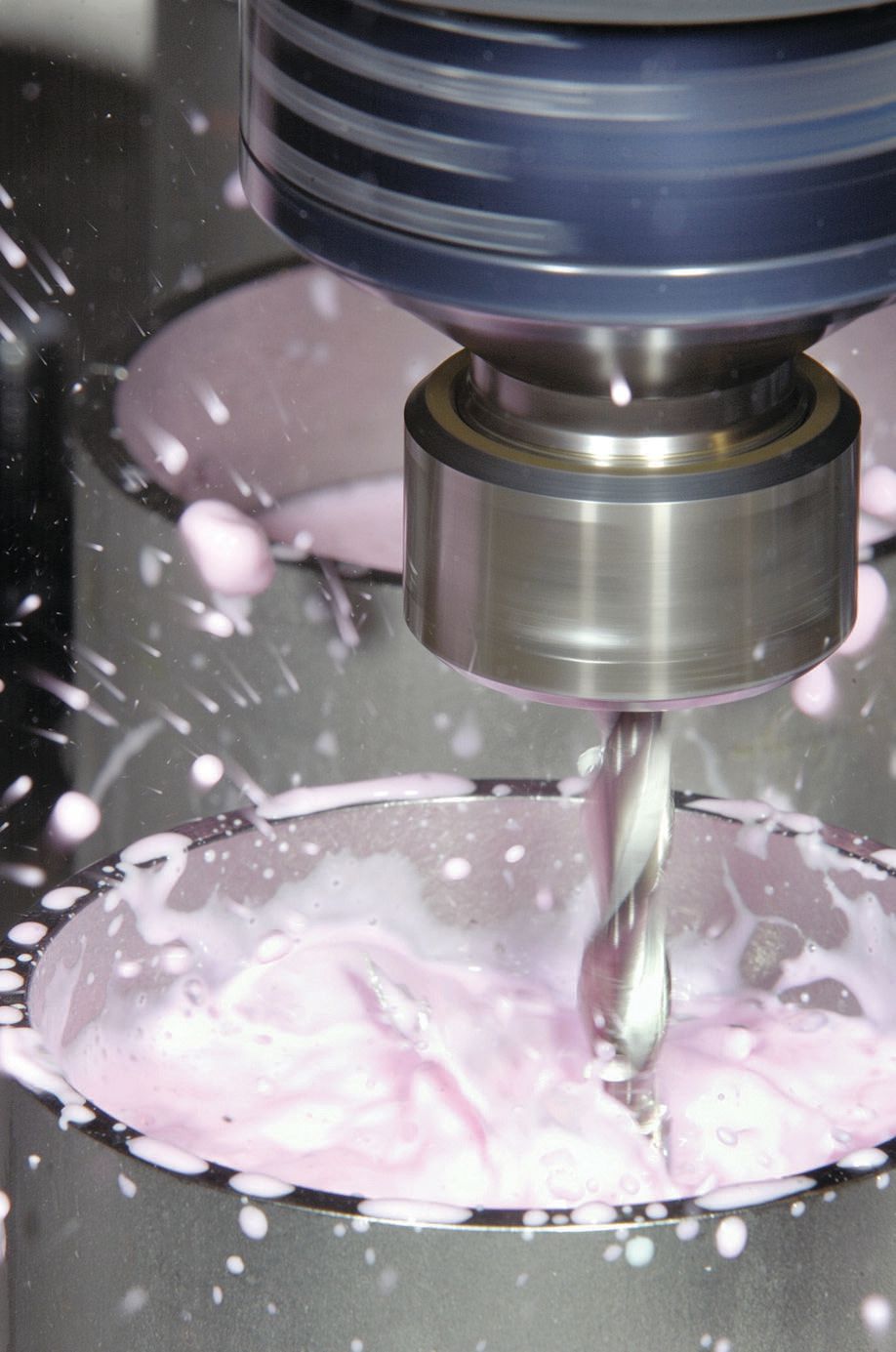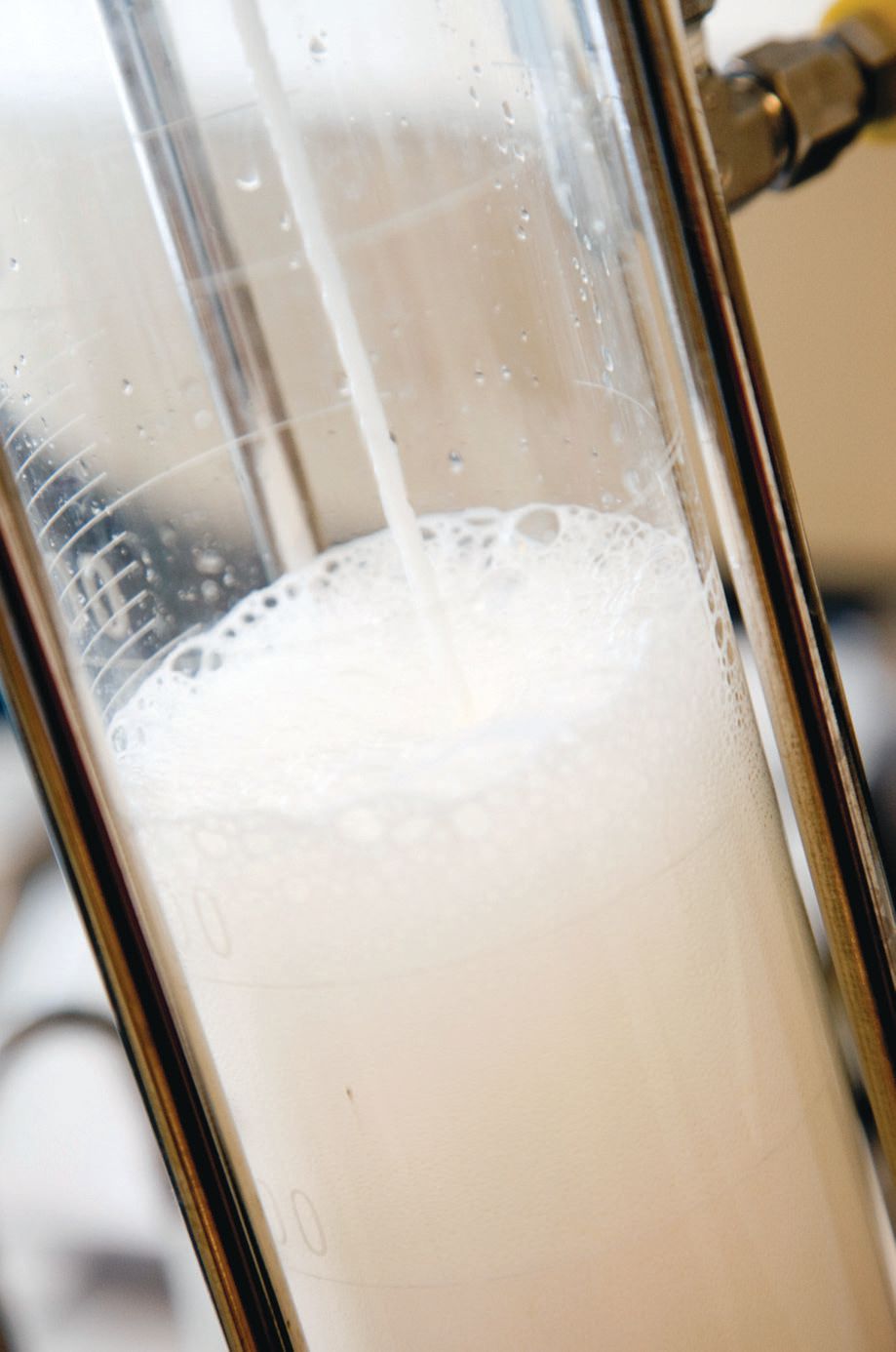The Lubrizol Corporation
Leading the Way in Metalworking Emulsifier Technology
By Scott Prickett, Metalworking Product Manager, The Lubrizol Corporation | TLT CMF Plus November 2014
For nearly a century, metalworking formulators have been attempting to combine the lubricating properties of oil with the cooling properties of water for their machining and grinding applications. Through this same time period, innovations in emulsifier technologies and finished fluid formulations have been required to meet the ever-changing machining challenges, and now ever-increasing environmental expectations, as well.
High speed machining, which is becoming the modern industry standard for a variety of metal alloys, may require through-the-tool fluid delivery systems for the applications. High speed machining creates an environment that stresses the emulsion stability and creates foam due to the accelerated tool speed and feed rates. In particularly difficult operations, the heat generated by the cutting processes strains the fluid and makes it difficult to provide the cooling and lubricity required to reduce tool wear, and also to provide corrosion protection to the freshly machined surfaces.
Much higher pressures are seen in many manufacturing processes, and when combined with a drive towards smaller system sump sizes, this provides another set of difficult challenges that formulators must ad dress as well. Foam can be the result of these high-pressure fluid flow conditions, and with reduced retention times in the sumps due to their smaller sizes, the formation of entrained air becomes a factor that influences fluid performance and dynamics. The point of cut in the machining process needs lubrication and cooling, not foam or entrained air. Significant reductions in tool life and increased tool wear are the results of excess system foam and entrained air conditions. Emulsifiers need to be low-foaming and release entrained air quickly to return the metalworking fluid to its normal state of operation.
 Figure 1. High-speed machining can require through-the-tool fluid delivery.
Figure 1. High-speed machining can require through-the-tool fluid delivery.
The demand for increased production throughput greatly decreases allowable downtime for maintenance, forcing operators to keep metalworking fluids in processes longer than ever before. Systems can experience higher contamination levels due to tramp oils, microbiological excursions and dirt loads, before they can be scheduled for a dump, clean, and recharge (DCR). These extended periods between DCRs require the metalworking fluids to have more robust emulsifiers to help provide sustainability to the fluids and even allow for recycling and extensive filtration of the fluid. Emulsifiers need to release tramp oils from the metalworking fluids to meet demands for extended sump life and to reduce maintenance for the metalworking fluid systems.
Emerging and more stringent regulatory requirements such as REACh and other similar global programs, along with security of supply strains, are also impacting emulsifier chemistry availability on a global, national, and local basis. These factors place additional pressure on metalworking fluid formulators to deliver finished materials that are sustainable and globally accepted. For example, in 2011, the fatty alcohol/ethoxylated emulsifier base was impacted by two supply disruption events of oleyl alcohols and both significantly impacted emulsifier ethoxylated technologies in supply, availability, and pricing. These two significant events impacted the metalworking industry worldwide and brought supply chain issues to the forefront of emulsifier formulators’ minds.
All of these market issues played a role in the development of Lubrizol’s latest advanced emulsifier technology, Lubrizol MC91T. Lubrizol supplies a wide variety of additives and emulsifier technologies that provide formulators with the building blocks they need to develop water-based metalworking fluids that meet the challenges of today’s ever-changing manufacturing and environmental processes. There is not one single chemistry that fits every application, so we are continually developing and evaluating our additives in traditional and newer applications to gain a better understanding of how they can benefit the metalworking formulator, and in turn, the finished fluid end user.
 Figure 2. Foam in metalworking fluids presents challenges.
Figure 2. Foam in metalworking fluids presents challenges.
Lubrizol MC91T was developed to provide end users of metalworking fluids with a differentiated emulsifier that has performance characteristics tailored specifically for the metalworking market. Our unique emulsifier technology exhibits outstanding emulsification efficiency, hydrolytic and amine stability, lower foam and hard water tolerance characteristics. Our emulsification efficiency, or stability, extends over a broad range of water hardness levels and allows for continued stability even as the metalworking fluid conditions become more strained and/or contaminated with fines and tramp oils. In the past, as metalworking fluids aged in the system, the emulsion stability would be reduced over time, resulting in reduced tool life and part quality. The robust Lubrizol MC91T technology releases tramp oils, which means that as the system ages, the performance levels are maintained and the integrity of the fluid is sustained for longer periods of time.
Traditional emulsifier chemistries provide supplemental corrosion protection. Next-generation technologies are built from core dispersant chemistry and provide cleaner operations, hard water stability and are less susceptible to biological growth due to their branched structure and absence of sulphur. Lubrizol MC91T exceeds the performance of traditional emulsifier chemistries and provides a solution to formulating more robust metalworking fluids for many applications. The low-foaming nature of this chemistry means that air is released from the system quickly, so even in challenging high-speed, high-pressure systems, the metalworking fluid will still provide ample lubrication and cooling properties.
 Figure 3. Lubrizol® MC91T emulsifies quickly and remains stable.
Figure 3. Lubrizol® MC91T emulsifies quickly and remains stable.
Lubrizol MC91T’s powerful emulsification properties allow this additive to be used with a variety of base stocks (especially Group II paraffinic oils) by simply adjusting the Hydrophilic-Lipophilic Balance (HLB) of the final emulsifier system. These powerful emulsification characteristics lead to significantly reduced treat rates vs. conventional ethoxylated alcohols emulsifiers. With reduced treat rates, lower overall fluid costs can be achieved, and the metalworking system will perform properly for the machining operation.
As regulation and performance requirements continue to change, metalworking formulators can be assured that Lubrizol will adapt and develop new products to help meet and exceed end-user and environmental demands. Lubrizol MC91T has extensive global registration and environmental approvals to meet our customer’s expectations of a global technology footprint. Global chemical compliances cover USA (TSCA), Mexico, Europe (REACh), Australia, Canada (DSL), Korea, and China. Lubrizol MC91T is compliant in almost every major manufacturing market, including Japan, where registration currently is being completed. Because this new technology is independent of the traditional ethoxylated technologies, it establishes a much improved supply chain stability base. If the events of 2011 were to repeat themselves in any form, the supply chain for Lubrizol MC91T would not be impacted. This technology provides formulators with the best alternative to replace existing emulsifier products being used in their metalworking fluids around the globe.
Lubrizol MC91T is a low-foaming surfactant that results in stable emulsions in a broad range of water quality conditions, and therefore ideal for through-the-tool coolant delivery systems that operate under higher pressures and smaller system capacities. This technology is well-suited as a primary and/or a secondary emulsifier in soluble oil and semi-synthetic water-based metalworking fluids to meet today’s challenging metalworking fluid performance requirements.
Lubrizol MC91T is the latest development in Lubrizol’s emulsifier additive portfolio that focuses on providing superior performance in an everchanging market. This technology meets or exceeds the demands of today’s market and provides low foaming tendencies, strong emulsion stability in hard water, and improved lubricity performance for water-based metalworking fluids. Future technologies will have the ability to be even more fine-tuned to meet even the most demanding of challenges and applications for specific customers. For today’s market and needs, Lubrizol MC91T is the best choice for improved productivity for water-based metalworking applications.
OIL + WATER + LUBRIZOL MC91T = IMPROVED PRODUCTIVITY